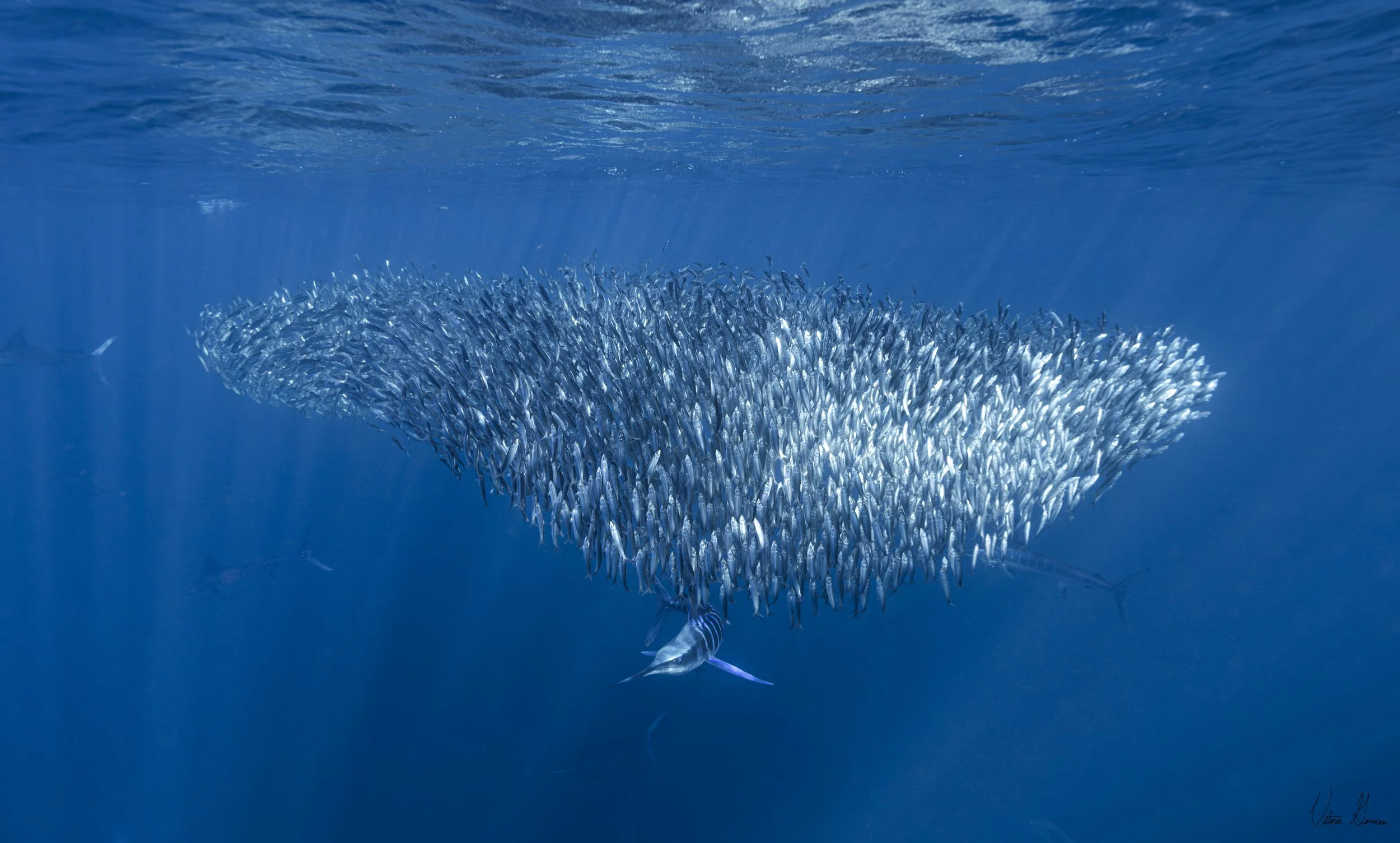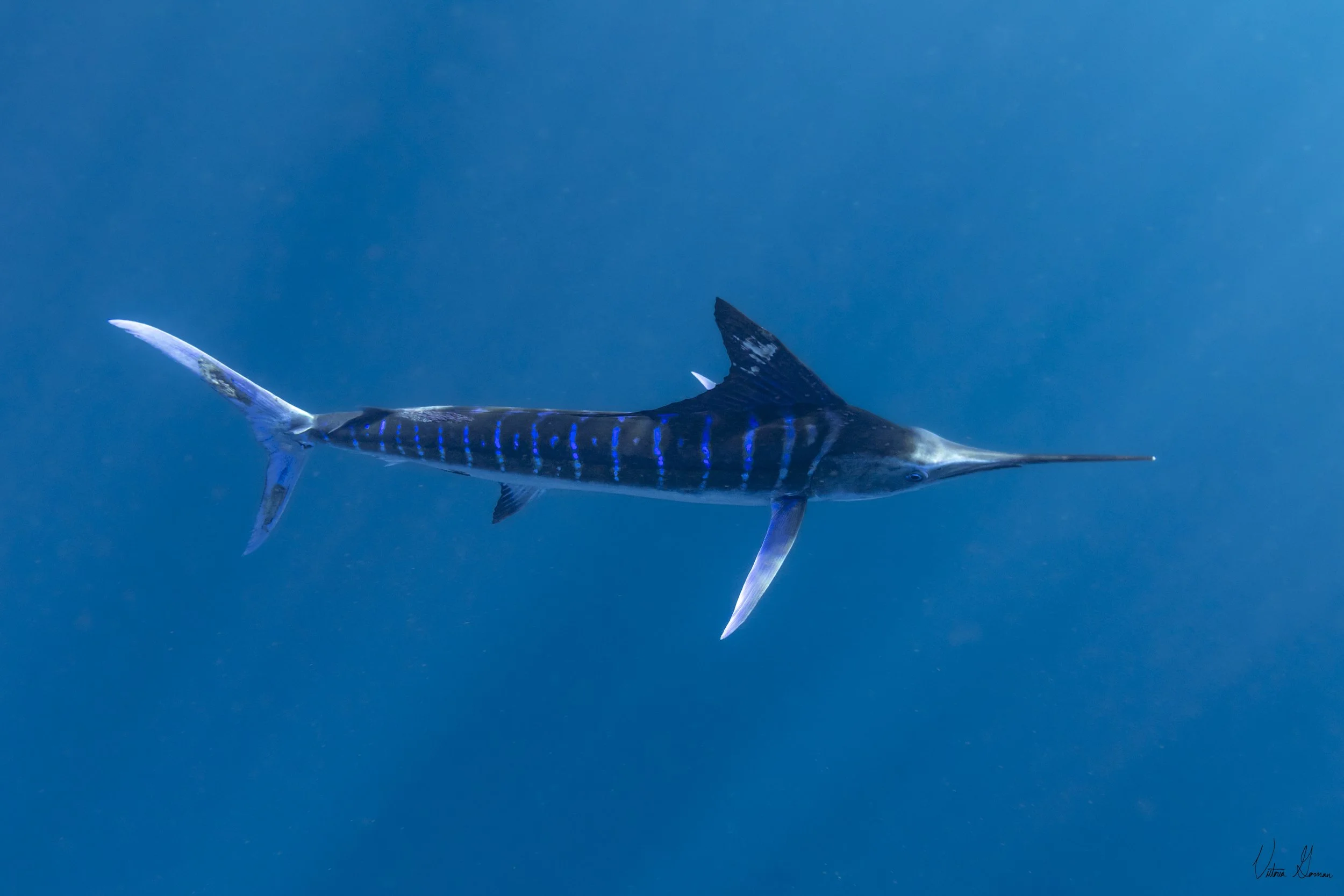Marlins vs Bait Ball
Magdalena Bay, Baja California Sur, Mexico
We set out on the boat that morning, a thick fog cloaking San Carlos as we pulled away from shore. The air was crisp, and we were bundled in jackets—the kind of cold that makes you feel alive. We passed through Magdalena Bay, its still waters giving way to the vastness of the open Pacific Ocean. For about an hour and a half, we rode out into the blue, scanning the horizon for frigatebirds and pelicans diving from above—a sign that something was happening below the surface. When birds gather like that, it usually means a bait ball is near, and where there’s a bait ball, there’s often something more.
After a few hours of searching, we found one.
Carefully, we slipped into the water and began swimming toward it. Just below us, the marlin circled. One by one, they took turns charging the bait ball. Before each strike, a marlin’s silvery-blue stripes would flash to a vivid, electric blue—signaling to the others that it was going in, a warning to avoid a chaotic collision. (Their ability to change color this way is well-documented, a fascinating display of biology and communication.)
We watched as they worked together, keeping the bait tightly packed and near the surface. Sometimes they didn’t even strike—they simply used their presence to herd the fish, guiding the ball where they wanted it to go. And as we floated above, we had to be aware of our position. The bait ball, sensing we posed no threat, often tried to take shelter near us, using our bodies as cover from the hunters.
We stayed with them for nearly an hour, suspended at the surface in awe. The marlin moved with such purpose, precision, and grace—it felt like watching a choreographed dance unfold just beneath the waves.
Time disappeared. When I finally climbed back onto the boat, fingers pruned and SD card full, I sat in silence, trying to absorb what I’d just experienced. It was one of those moments that imprints itself in your memory—not just for the images I captured, but for the quiet magic of witnessing the wild in perfect motion.
This image is one of my favorites and will always hold a special place in my heart. I remember watching the bait ball dart suddenly upward, moving in a burst of instinctive urgency. Just beneath them, a marlin appeared—swift and powerful—its eyes meeting mine for a brief, electric moment. I felt like I had been pulled into the rhythm of the hunt. I wasn’t just observing the dance—I was part of it. This photo later became the first piece of mine to be recognized publicly. It was selected for the Ocean Symphony Gala—a charity auction supporting FOMARES and SeaLegacy and their efforts to protect marine ecosystems and advance sustainable ocean conservation throughout Baja California. To know that this image could both tell a story and contribute to something greater was incredibly meaningful for me.
I was focused on capturing images of the bait ball when, before I realized it, they were directly beneath me—rising fast, searching for protection. Just after I took this photo, I had to quickly swim backward—knowing a marlin could be moments behind them, slicing through the ball in pursuit. It all happened in a matter of seconds. Moments like this remind me how alive the ocean is, and how quickly you can go from observer to part of the scene.
This image is a simple, up-close display of the beautiful, vivid colors of a marlin just before it charges a bait ball. Their ability to communicate through color changes is nothing short of spectacular. These striking shifts in hue are caused by specialized cells in their skin called chromatophores, which expand or contract to reflect different wavelengths of light. When preparing to strike, the marlin’s silvery-blue stripes transform into a brilliant, electric blue—sending a clear signal to other marlin in the area to avoid collisions and maintain the flow of their coordinated hunt.
This image captures a powerful moment—a marlin working to keep the bait ball pressed toward the surface, slipping into the shade beneath it to maintain control. My favorite part of this scene is something quieter, though: the scattered scales left behind from the sardines and mackerel that had already been eaten. They glisten in the sunlight filtering through the surface- mother nature's environmentally friendly glitter.
This image shows two marlin circling in rhythm beneath the bait ball, moving with coordination and intent. I love the shape the bait ball takes here—and how the sunlight creates a gradient of luminance across it. You can see the difference as the fish angle in different directions: the left side of the ball is shifting upward, catching more light, while the right side moves downward into shadow. It’s a beautiful moment of motion, light, and natural symmetry.




